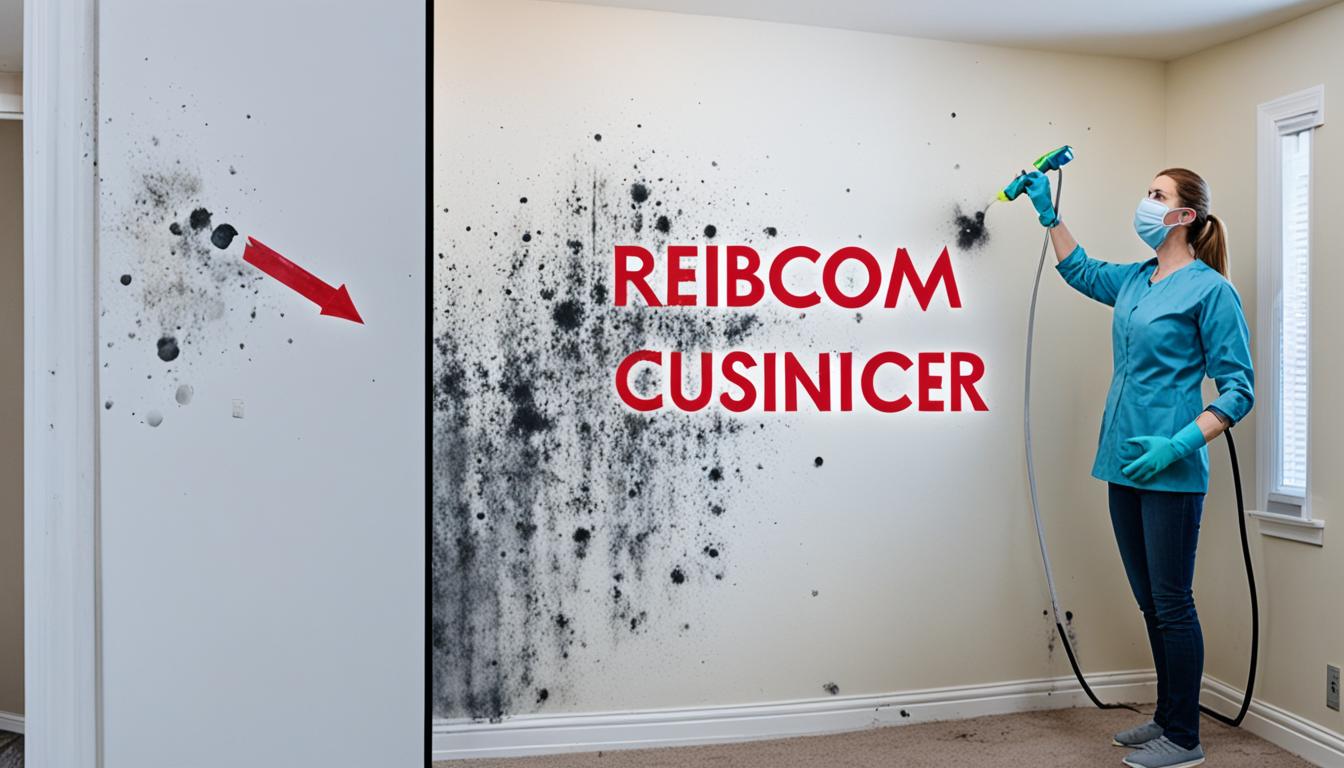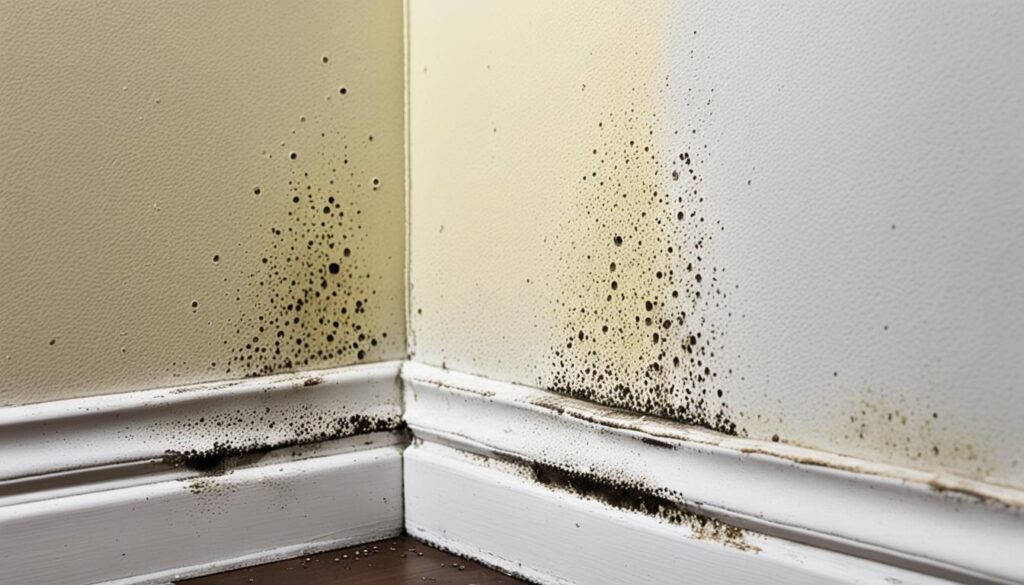
Eradicate Mold: Secure Your Home Environment
Welcome to our comprehensive guide on how to get rid of mold in your house, creating a cleaner living space and a healthier environment for you and your family. Mold is a common problem that can lead to various health issues and compromise the structural integrity of your home. By following expert strategies and implementing proven techniques, you can eliminate mold and prevent its reoccurrence, ensuring a mold-free future.
Key Takeaways:
- Understanding how to identify mold is crucial for effective removal.
- Regular cleaning and maintenance can help prevent mold growth.
- Using appropriate protective measures during mold removal is important for personal safety.
- Addressing underlying moisture issues is essential to prevent mold from coming back.
- Professional mold assessments can provide expert guidance and assistance.
Identifying Mold: Signs and Symptoms
Before diving into the methods of mold removal, it’s crucial to know how to identify mold in your house. By recognizing the signs and symptoms of mold presence, you can take timely action to address the issue and protect your home environment. Here are some common indications of mold infestation:
- Visual Clues: Mold often appears as black, brown, green, or white patches on walls, ceilings, or other surfaces. Keep an eye out for any discoloration or growth that resembles fuzzy or slimy texture.
- Musty Odor: Mold typically emits a strong, unpleasant smell. If you notice a persistent musty odor in a certain area of your house, it could be a sign of hidden mold growth.
- Allergic Reactions: Symptoms like nasal congestion, sneezing, coughing, watery eyes, or skin irritation can indicate mold exposure. If these symptoms worsen when you’re at home and improve when you’re away, it could be due to mold in your living environment.
- Water Damage History: Any past incidents of leaks, flooding, or water damage increase the likelihood of mold growth. If you’ve experienced such issues, it’s essential to inspect the affected areas for signs of mold.
“Mold often appears as black, brown, green, or white patches on walls, ceilings, or other surfaces.”
To help you recognize potential mold-infested areas in your home, refer to the following table:

| Area | Signs of Mold |
|---|---|
| Bathrooms | Damp, musty smell, discoloration on walls or ceilings, warped or bubbling paint |
| Kitchens | Mold growth around sinks, dishwasher, or refrigerator, musty odor from cabinets |
| Basements | Water stains, visible mold growth on surfaces or belongings, musty smell |
| Attics | Water stains, roof leaks, visible mold growth on insulation or wood |
| Laundry Rooms | Dampness, mold growth on walls, floors, or behind appliances |
| Window Sills | Condensation, moisture, visible mold growth |
If you observe any of these signs or suspect mold presence in your house, it’s important to take immediate action. In the next section, we will explore effective mold removal techniques to help you address the issue and create a healthier living environment for you and your family.
Effective Mold Removal Techniques
Once you have identified the presence of mold, it’s crucial to take immediate action and eliminate it from your house. Mold not only causes structural damage but also poses health risks to you and your family. In this section, we will provide step-by-step instructions on effective mold removal techniques to help you create a safe and mold-free environment in your home.
1. Gather the necessary supplies
Before starting the mold removal process, gather the following supplies:
- Protective gear: gloves, mask, goggles, and disposable coveralls
- Cleaning solutions: bleach, hydrogen peroxide, or commercial mold cleaners
- Scrub brush or sponge
- Plastic bags and trash containers for mold-infested materials
2. Prepare the affected area
Prioritize safety by sealing off the affected area to prevent mold spores from spreading to other parts of your home. Close doors and windows and cover vents with plastic sheets. This containment will minimize the risk of cross-contamination during the removal process.
3. Remove mold-infested materials
For severe cases of mold growth, it may be necessary to remove and discard heavily contaminated materials such as drywall, carpeting, or insulation. Carefully bag and seal these items, ensuring they are completely removed from your home to prevent further mold spread.
4. Clean with appropriate solutions
Use a suitable cleaning solution to effectively eliminate mold from hard surfaces. Bleach, hydrogen peroxide, or commercial mold cleaners can be used, depending on the type of surface and severity of the mold growth. Dilute the solution as instructed and scrub the affected areas thoroughly, ensuring all visible mold is removed.
5. Dry the area thoroughly
Mold thrives in damp environments, so it’s essential to dry the affected area completely after cleaning. Use fans, dehumidifiers, or open windows to promote air circulation and reduce moisture levels. This step is crucial in preventing mold regrowth.
6. Implement preventive measures
Prevention is key to avoiding future mold problems. Here are a few preventive strategies to consider:
- Control indoor humidity levels by using dehumidifiers or ensuring proper ventilation.
- Fix any water leaks or plumbing issues as soon as they are detected.
- Regularly clean and inspect areas prone to moisture, such as bathrooms, kitchens, and basements.
- Ensure proper insulation and ventilation in attics, crawl spaces, and basements.
By following these effective mold removal techniques and implementing preventive measures, you can create a mold-free environment in your home. Remember, extensive mold infestations may require professional assistance. If you’re facing persistent mold problems, consider contacting a reputable mold removal service for expert guidance and remediation.

Conclusion
By implementing the strategies and techniques mentioned in this article, you can successfully eradicate mold from your house, ensuring a cleaner and healthier living environment for you and your family. Regularly inspecting your home for signs of mold, promptly addressing any water damage or leaks, and taking appropriate preventive measures can help maintain a mold-free space.
However, if you require expert assistance or professional mold assessments, Fix Mold Miami is here to help. With their team of experienced professionals, you can trust them to provide comprehensive mold removal services tailored to your specific needs. Don’t hesitate to reach out to Fix Mold Miami at 305-465-6653 for a thorough mold assessment and reliable solutions.
Take control of your home environment today and secure a mold-free future. By adopting these proactive measures and seeking professional guidance when needed, you can create a safer and healthier living space for you and your loved ones.




